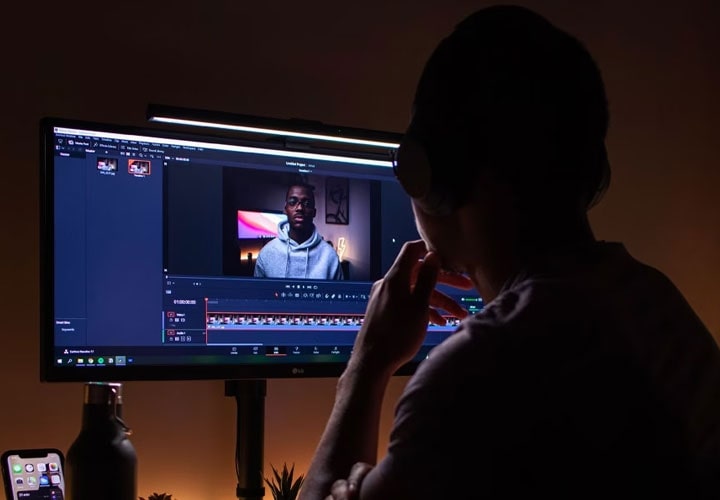
Introduction: Why Choosing the Right Monitor Matters
Spending long hours in front of a computer screen is a reality for many of us. Whether you're a programmer, writer, graphic designer, or simply working from home, the strain on your eyes can be significant. Choosing the right monitor is crucial for protecting your vision and improving your overall comfort and productivity. This article will explore the key features to look for in a monitor that minimizes eye strain and suggest some of the best options available.
Understanding Eye Strain and Its Causes
Eye strain, also known as asthenopia, is a common condition characterized by tired, sore, or burning eyes. Prolonged use of digital devices is a major contributor to eye strain, and several factors contribute to this:
Blue Light Emission
Monitors emit blue light, a high-energy visible light that can disrupt sleep patterns and contribute to eye fatigue. Extended exposure to blue light can potentially damage retinal cells over time, although more research is still ongoing in this area.
Flicker
Many monitors use pulse-width modulation (PWM) to control brightness. This can cause subtle flickering, which is often imperceptible but can still lead to eye strain and headaches, especially with prolonged use.
Glare
Reflections on the monitor screen from ambient light sources can force your eyes to work harder to focus, contributing to eye strain.
Poor Ergonomics
Incorrect monitor height, distance, and angle can lead to poor posture, neck pain, and eye strain. Maintaining a proper ergonomic setup is essential for long-term comfort.
Key Features to Look for in an Eye-Strain-Reducing Monitor
When choosing a monitor to minimize eye strain, consider these important features:
Low Blue Light Filter
A low blue light filter reduces the amount of blue light emitted by the monitor, helping to alleviate eye fatigue and improve sleep quality. Many monitors offer adjustable blue light filter settings, allowing you to customize the level of reduction.
Flicker-Free Technology
Flicker-free technology eliminates PWM, providing a stable and consistent image that reduces eye strain. Look for monitors that are explicitly advertised as "flicker-free."
Anti-Glare Coating
An anti-glare coating reduces reflections on the screen, making it easier to see the content and minimizing eye strain. Matte finishes are generally more effective than glossy finishes.
High Resolution and Pixel Density
A higher resolution (e.g., 1440p or 4K) and higher pixel density (pixels per inch, or PPI) result in sharper, clearer images. This reduces the need for your eyes to strain to focus on small details, leading to less fatigue.
Adjustable Brightness and Contrast
Being able to adjust the brightness and contrast levels of your monitor is crucial for adapting to different lighting conditions. Lowering the brightness in dimly lit environments can significantly reduce eye strain.
Ergonomic Stand
An ergonomic stand allows you to adjust the height, tilt, and swivel of the monitor to achieve the optimal viewing position. This promotes good posture and reduces neck and eye strain. Consider a monitor arm for even greater flexibility.
Curved Screen (Optional)
Some users find that curved monitors are more comfortable for long hours of use. The curvature can create a more immersive experience and reduce eye strain by minimizing the amount of eye movement required to view the entire screen.
Recommended Monitors for Eye Strain and Long Hours
Here are some of the best monitors currently available that prioritize eye comfort and reduce strain:
BenQ GW2780T
The BenQ GW2780T is a popular choice for its focus on eye care features. It boasts Brightness Intelligence Technology (B.I. Tech), which automatically adjusts the brightness based on ambient lighting conditions. It also features low blue light and flicker-free technologies, making it an excellent option for long work sessions. It also has an ergonomic stand.
ASUS Eye Care Monitors (e.g., ASUS VA24EHE)
ASUS offers a range of "Eye Care" monitors designed to minimize eye strain. These monitors typically include low blue light filters, flicker-free technology, and anti-glare coatings. The ASUS VA24EHE, for example, is a good budget-friendly option with these features.
Dell UltraSharp U2723QE
The Dell UltraSharp U2723QE is a high-quality monitor with excellent color accuracy and a comfortable viewing experience. It features ComfortView Plus technology, which reduces blue light emissions without sacrificing color accuracy. It also has a flicker-free panel and an anti-glare coating, and an adjustable stand for optimal ergonomics. The 4K resolution provides a sharp and detailed image, further reducing eye strain.
LG UltraFine Ergo Monitors (e.g., LG 27UN880-B)
LG UltraFine Ergo monitors are known for their exceptional ergonomics. The "Ergo" stand offers a wide range of adjustments, including height, tilt, swivel, and even extension/retraction. This allows you to position the monitor perfectly for your needs, minimizing neck and eye strain. These monitors also feature low blue light and flicker-free technologies, combined with excellent image quality.
EIZO FlexScan Series
EIZO FlexScan monitors are renowned for their high-quality panels and advanced eye-care features. They incorporate technologies like Auto EcoView, which automatically adjusts brightness based on ambient light, and Paper Mode, which reduces blue light to mimic the appearance of paper. EIZO monitors are often more expensive, but they offer exceptional performance and comfort for users who spend long hours in front of a screen.
Beyond the Monitor: Other Tips for Reducing Eye Strain
Choosing the right monitor is just one piece of the puzzle. Here are some additional tips to help reduce eye strain:
The 20-20-20 Rule
Every 20 minutes, look at an object 20 feet away for 20 seconds. This helps to relax your eye muscles and prevent fatigue.
Blink Frequently
Staring at a screen can reduce your blink rate, leading to dry eyes. Make a conscious effort to blink more often.
Adjust Room Lighting
Avoid harsh overhead lighting and position your monitor to minimize glare. Use a desk lamp to provide additional illumination if needed.
Use Eye Drops
If you experience dry eyes, use artificial tears to lubricate your eyes.
Get Regular Eye Exams
Regular eye exams are essential for detecting and addressing any underlying vision problems that may contribute to eye strain.
